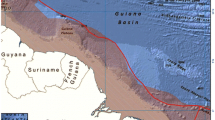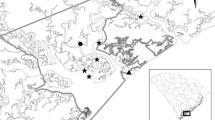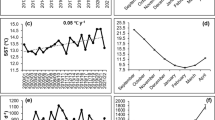Abstract
Shrimps are an important and valuable fishing resource, being increasingly exploited worldwide, demanding appropriate management. However, factors such as how shrimps are affected by environmental variables and how such variables are likely to change under a climate change scenario are still poorly known. We used a Brazilian database with 10 years of shrimp catch and effort data, from 20 different small-scale equatorial fishing ports, to test how shrimp fishing productivity is affected by environmental (sea surface temperature (SST), wind, precipitation, and cloudiness), economic (ex-vessel price), spatial (fishing port), and temporal factors (year and month). The results showed that better productivities are reached at higher SST (to a limit 26 °C) and precipitation. Time (year) and space (different fishing villages showed different fishing success) also affected the fishing success. Considering that both temperature and precipitation were important determinants of shrimp productivity, we estimated how such productivity would be affected by climate change. Our results suggest that these fisheries could collapse in a warmer and drier future, which is a possible scenario for the region. Overall, a better understanding of regional shrimp fisheries could permit the development of tailor-made management measures. Besides, this study also shows how an economically important invertebrate stock is sensitive to climate change, which is a warning signal to developing countries, where there is a significant parcel of its population directly dependent on fishery exploitation.







Similar content being viewed by others
References
Allison EH, Perry AL, Badjeck M-C, Neil-Adger W, Brown K, Conway D, Halls AS, Pilling GM, Reynolds JD, Andrew NL, Dulvy NK (2009) Vulnerability of national economies to the impacts of climate change on fisheries. Fish Fish 10:173–196. doi:10.1111/j.1467-2979.2008.00310.x
Almeida AC, Baeza JA, Fransozo V, Castilho AL, Fransozo A (2012) Reproductive biology and recruitment of Xiphopenaeus kroyeri in a marine protected area in the Western Atlantic: implications for resource management. Aquat Biol 17:57–69. doi:10.3354/ab00462
Ambrizzi T, Araújo M (2012) Sumário executivo: primeiro relatório de avaliação nacional. Painel Brasileiro de Mudanças Climáticas, Rio de Janeiro
Andrade LAC (2015) Estratégias de exploração e comércio da pesca artesanal de polvo. Dissertation, Universidade Federal do Rio Grande do Norte
Arellano-Torres A, Pérez-Castañeda R, Defeo O (2006) Effects of a fishing gear on an artisanal multispecific penaeid fishery in a coastal lagoon of Mexico: mesh size, selectivity and management implications. Fish Manag Ecol 13:309–317. doi:10.1111/j.1365-2400.2006.00507.x
Arnason R (2007) Climate change and fisheries: assessing the economic impact in Iceland and Greenland. Nat Resour Model 20:163–197. doi:10.1111/j.1939-7445.2007.tb00205.x
Arreguin-Sanchez F, Zetina-Rejón M, Ramírez-Rodríguez M (2008) Exploring ecosystem-based harvesting strategies to recover the collapsed pink shrimp (Farfantepenaeus duorarum) fishery in the southern Gulf of Mexico. Ecol Model 214:83–94. doi:10.1016/j.ecolmodel.2007.11.021
Begossi A (2010) Small-scale fisheries in Latin America: management models and challenges. Maritime Studies 9:5–12
Béné C, MacFadyen G, Allison EH (2005) Increasing the contribution of small-scale fisheries to poverty alleviation and food security. FAO, Rome
Browder JA, Zein-Eldin Z, Criales MM, Robblee MB, Wong S, Jackson TL, Johnson D (2002) Dynamics of pink shrimp (Farfantepenaeus duorarum) recruitment potential in relation to salinity and temperature in Florida bay. Estuaries 25:1355–1371. doi:10.1007/BF02692230
Capparelli MV, Kasten P, Castilho AL, Costa RC (2012) Ecological distribution of the shrimp Litopenaeus schmitti (Burkenroad, 1936) (Decapoda, Penaeoidea) in Ubatuba Bay, São Paulo, Brazil. Invertebr Reprod Dev 56:173–179. doi:10.1080/07924259.2011.587272
Castilho AL, Pie MR, Fransozo A, Pinheiro AP, Costa RC (2008) The relationship between environmental variation and species abundance in shrimp community (Crustacea: Decapoda: Penaeoidea) in south-eastern Brazil. J Mar Biol Assoc U K 88:119–123. doi:10.1017/S0025315408000313
Castro RH, Costa RC, Fransozo A, Mantelatto FL (2005) Population structure of the seabob shrimp Xiphopenaeus kroyeri (Heller, 1862)(Crustacea: Penaeoidea) in the littoral of São Paulo, Brazil. Sci Mar 69:105–112
Christensen V, Guénette S, Heymans JJ, Walters CJ, Watson R, Zeller D, Pauly D (2003) Hundred-year decline of North Atlantic predatory fishes. Fish Fish 4:1–24. doi:10.1046/j.1467-2979.2003.00103.x
Cinner J (2005) Socioeconomic factors influencing customary marine tenure in the Indo-Pacific. Ecol Soc 10:36
Cinner JE, McClanahan TR, Graham NAJ, Daw TM, Maina J, Stead SM, Wamukota A, Brown K, Bodin O (2012) Vulnerability of coastal communities to key impacts of climate change on coral reef fisheries. Glob Environ Change 22:12–20. doi:10.1016/j.gloenvcha.2011.09.018
Cinner JE, Pollnac RB (2004) Poverty, perceptions and planning: why socioeconomics matter in the management of Mexican reefs. Ocean Coast Manag 47:479–493. doi:10.1016/j.ocecoaman.2004.09.002
Cleveland WS (1979) Robust locally weighted regression and smoothing scatterplots. J Am Stat Assoc 74:829–836. doi:10.1080/01621459.1979.10481038
de Damasio MAL, Lopes PFM, Pennino MG, Carvalho AR, Sumaila R (2016) Size matters: fishing less and yielding more in smaller-scale fisheries. ICES J Mar Sci J Cons:fsw016. doi:10.1093/icesjms/fsw016
Davis JL, Metcalfe WJ, Hines AH (2003) Implications of a fluctuating fish predator guild on behavior, distribution, and abundance of a shared prey species: the grass shrimp Palaemonetes pugio. J Exp Mar Biol Ecol 293:23–40. doi:10.1016/S0022-0981(03)00122-9
D’Incao F, Delevedove G, Maggini DE, Maggioni R (1998) Evidência genética da presença de Farfantepenaeus paulensis (Pérez Farfante 1967) no litoral nordeste do Brasil (Decapoda: Penaeidae). Nauplius 6:129–137
D’Incao F, Valenti H, Rodrigues LF (2002) Avaliação da pesca de camarões nas regiões sudeste e sul do Brazil. 1965-1999. Atlantica 24:103–116
Eutrópio FJ, Mariante FLF, Junior PDF, Krohling W (2012) Population parameters of the shrimp Xiphopenaeus kroyeri (Heller, 1862) (Crustacea, Penaeidae), caught by artisanal fisheries in Anchieta, Espírito Santo state - doi: 10.4025/actascibiolsci.v35i2.13408. Acta Sci Biol Sci 35:141–147. doi:10.4025/actascibiolsci.v35i2.13408
FAO (2014) The state of world fisheries and aquaculture: opportunities and challenges. FAO, Rome
Ferreira L, Medley P (2005) The southern pink shrimp (Farfantepenaeus notialis) and Atlantic seabob (Xiphopenaeus kroyeri) fisheries of the Trinidad and Tobago trawl fishery. In: CRFM Fishery Report. Secretariat of the Caribbean Regional Fisheries Mechanism, Belize, pp 63–88
Forney K (2000) Environmental models of Cetacean abundance: reducing uncertainty in population trends. Conserv Biol 14:1271–1286
Freire FA, Luchiari AC, Fransozo V (2011) Environmental substrate selection and daily habitual activity in Xiphopenaeus kroyeri shrimp (Heller, 1862) (Crustacea: Penaeioidea). Indian J Mar Sci 40:325
Furlan M, Castilho AL, Fernandes-Góes LC, Fransozo V, Bertini G, Costa RC (2013) Effect of environmental factors on the abundance of decapod crustaceans from soft bottoms off southeastern Brazil. An Acad Bras Cienc 85:1345–1356. doi:10.1590/0001-3765201394812
Garcia S, Reste LL (1986) Ciclo vitales, dinámica explotación y ordenación de las poblaciones de camarones peneidos costeros. FAO, Rome
Gelcich S, Kaiser MJ, Castilla JC, Edwards-Jones G (2008) Engagement in co-management of marine benthic resources influences environmental perceptions of artisanal fishers. Environ Conserv 35:36–45
Gillett R (2008) Global study of shrimp fisheries. FAO, Rome
Gusmão J, Lazoski C, Monteiro FA, Solé-Cava AM (2006) Cryptic species and population structuring of the Atlantic and Pacific seabob shrimp species, Xiphopenaeus kroyeri and Xiphopenaeus riveti. Mar Biol 149:491. doi:10.1007/s00227-005-0232-x
Halpern BS, Walbridge S, Selkoe KA, Kappel CV, Fiorenza M, D’Agroza C, Bruno JF, Casey KS, Ebert C, Fox HE, Heinemann D, Lenihan HS, Madin EMP, Perry MT, Selig ER, Spalding M, Steneck R, Watson R (2008) A global map of human impact on marine ecosystems. Science 319:948–952. doi:10.1126/science.1149345
Harley CDG, Randall Hughes A, Hultgren KM, Miner BG, Sorte CJB, Thornber CS, Rodriguez LF, Tomanek L, Williams SL (2006) The impacts of climate change in coastal marine systems. Ecol Lett 9:228–241. doi:10.1111/j.1461-0248.2005.00871.x
Heckler GS, da Costa RC, Fransozo A, Rosso S, Shimizu RM (2014) Long-term patterns of spatial and temporal distribution in the seabob shrimp Xiphopenaeus kroyeri (Decapoda: Penaeidae) population in southeastern Brazil. J Crustac Biol 34:326–333. doi:10.1163/1937240X-00002231
Hilborn R, Branch TA, Ernst B, Magnusson A, Minte-Vera C, Scheurell MD, Valero JL (2003) State of the world’s fisheries. Annu Rev Environ Resour 28:359–399. doi:10.1146/annurev.energy.28.050302.105509
Jackson JBC, Kirby MX, Berger WH, Bjorndal KA, Botsford LW, Bourque BJ, Bradbury RH, Cooke R, Erlandson J, Estes JA, Hughes TP, Kidwell S, Lange CB, Lenihan HS, Pandolfi JM, Peterson CH, Steneck RS, Tegner MJ, Warner RR (2001) Historical overfishing and the recent collapse of coastal ecosystems. Science 293:629–637. doi:10.1126/science.1059199
Lloret J, Lleonart J, Solé I, Fromentin J-M (2001) Fluctuations of landings and environmental conditions in the north-western Mediterranean Sea. Fish Oceanogr 10:33–50. doi:10.1046/j.1365-2419.2001.00151.x
Lopes PFM (2008) Extracted and farmed shrimp fisheries in Brazil: economic, environmental and social consequences of exploitation. Environ Dev Sustain 10:639–655
Madrid-Vera J, Amezcua F, Morales-Bojórquez E (2007) An assessment approach to estimate biomass of fish communities from bycatch data in a tropical shrimp-trawl fishery. Fish Res 83:81–89. doi:10.1016/j.fishres.2006.08.026
Marengo JA, Chou SC, Kay G, Alves LM, Pesquero JF, Soares WR, Santos DC, Lyra AA, Sueiro G, Betts R, Chagas DJ, Gomes JL, Bustamante J, Tavares P (2011) Development of regional future climate change scenarios in South America using the Eta CPTEC/HadCM3 climate change projections: climatology and regional analyses for the Amazon, São Francisco and the Paraná River basins. Clim Dyn 38:1829–1848. doi:10.1007/s00382-011-1155-5
Myers RA, Worm B (2003) Rapid worldwide depletion of predatory fish communities. Nature 423:280–283. doi:10.1038/nature01610
Ortega L, Celentano E, Delgado E, Defeo O (2016) Climate change influences on abundance, individual size and body abnormalities in a sandy beach clam. Mar Ecol Prog Ser 545:203–213. doi:10.3354/meps11643
Otero J, Álvarez-Salgado X, González AF, Miranda A, Groom SB, Cabanas JM, Casas G, Wheatley B, Guerra A (2008) Bottom-up control of common octopus Octopus vulgaris in the Galician upwelling system, northeast Atlantic Ocean. Mar Ecol Prog Ser 362:181–192. doi:10.3354/meps07437
Pantaleão JAF, Carvalho-Batista A, Fransozo A, da Costa RC (2016) The influence of upwelling on the diversity and distribution of marine shrimp (Penaeoidea and Caridea) in two tropical coastal areas of southeastern Brazil. Hydrobiologia 763:381–395. doi:10.1007/s10750-015-2429-4
Pauly D, Christensen V, Dalsgaard J, Froese R, Francisco T (1998) Fishing down marine food webs. Science 279:860–863. doi:10.1126/science.279.5352.860
Pauly D, Hilborn R, Branch TA (2013) Fisheries: does catch reflect abundance? Nature 494:303–306. doi:10.1038/494303a
Pennino MG, Thomé-Souza MJF, Carvalho AR, Fontes LCS, Parente C, Lopes PFM (2016) A spatial multivariate approach to understand what controls species catch composition in small-scale fisheries. Fish Res 175:132–141. doi:10.1016/j.fishres.2015.11.028
Pérez-Castañeda R, Defeo O (2005) Growth and mortality of transient shrimp populations (Farfantepenaeus spp.) in a coastal lagoon of Mexico: role of the environment and density-dependence. ICES J Mar Sci J Cons 62:14–24. doi:10.1016/j.icesjms.2004.10.005
Pérez-Jar L, Ramos Trujillo L (2010) Desempeño reproductivo de Litopenaeus schmitti de cultivo en condiciones comerciales. Revista cubana de investigaciones pesqueras 27:14–20
Pershing AJ, Alexander MA, Hernandez CM, Kerr LA, Bris AL, Mills KE, Nye JA, Record NR, Scannell HA, Sherwood GD, Thomas AC (2015) Slow adaptation in the face of rapid warming leads to collapse of the Gulf of Maine cod fishery. Science 350:809–812. doi:10.1126/science.aac9819
Pinnegar JK, Hutton TP, Placenti V (2006) What relative seafood prices can tell us about the status of stocks. Fish Fish 7:219–226. doi:10.1111/j.1467-2979.2006.00219.x
Development Team R (2017) R: a language and environment for statistical computing. R Foundation for Statistical Computing, Vienna
Ravier C, Fromentin J-M (2001) Long-term fluctuations in the eastern Atlantic and Mediterranean bluefin tuna population. ICES J Mar Sci J Cons 58:1299–1317. doi:10.1006/jmsc.2001.1119
Russell BD, Thompson J-AI, Falkenberg LJ, Connell SD (2009) Synergistic effects of climate change and local stressors: CO2 and nutrient-driven change in subtidal rocky habitats. Glob Chang Biol 15:2153–2162. doi:10.1111/j.1365-2486.2009.01886.x
Santos MB, González-Quirós R, Riveiro I, Cabanas JM, Porteiro C, Pierce GJ (2012) Cycles, trends, and residual variation in the Iberian sardine (Sardina pilchardus) recruitment series and their relationship with the environment. ICES J Mar Sci 69:739–750
Santos MCF, Ivo CTC (2000) Pesca, biologia e dinâmica populacional do camarão sete-barbas, Xiphopenaeus kroyeri (Heller, 1862) (Crustacea: Decapoda: Penaeidae), capturado em frente ao município de Caravelas (Bahia- Brasil). Bol Tec Cient CEPENE 8:131–164
Silva ACC, Castilhos JC, Santos EAP, Brondízio LS, Bugoni L (2010) Efforts to reduce sea turtle bycatch in the shrimp fishery in Northeastern Brazil through a co-management process. Ocean Coast Manag 53:570–576. doi:10.1016/j.ocecoaman.2010.06.016
Simões SM, Costa RC, Fransozo A, Castilho AL (2010) Diel variation in abundance and size of the seabob shrimp Xiphopenaeus kroyeri (Crustacea, Penaeoidea) in the Ubatuba region, Southeastern Brazil. An Acad Bras Ciênc 82:369–378. doi:10.1590/S0001-37652010000200013
Simpson AW, Watling L (2006) An investigation of the cumulative impacts of shrimp trawling on mud-bottom fishing grounds in the Gulf of Maine: effects on habitat and macrofaunal community structure. ICES J Mar Sci 63:1616–1630
Sobrino I, Juarez A, Rey J, Romero Z, Baro J (2011) Description of the clay pot fishery in the Gulf of Cadiz (SW Spain) for Octopus vulgaris: selectivity and exploitation pattern. Fish Res 108:283–290. doi:10.1016/j.fishres.2010.12.022
Sonderblohm CP, Pereira J, Erzini K (2014) Environmental and fishery-driven dynamics of the common octopus (Octopus vulgaris) based on time-series analyses from leeward Algarve, southern Portugal. ICES J Mar Sci 71:2231–2241. doi:10.1093/icesjms/fst189
Stoner AW, Zimmerman RJ (1988) Food pathways associated with penaeid shrimps in a mangrove-fringed estuary. Fish Bull 86:543–551
Sumaila UR, Lam VWY (2015) Out of stock: the impact of climate change on British Columbia’s staple seafood supply and prices. Vancity, Vancouver
Sumaila UR, Marsden AD, Watson R, Pauly D (2007) A global ex-vessel fish price database: construction and applications. J Bioecon 9:39–51. doi:10.1007/s10818-007-9015-4
Swartzman LC, Gwadry FG, Shapiro AP, Teasell RW (1994) The factor structure of the coping strategies questionnaire. Pain 57:311–316
Sydeman WJ, Poloczanska E, Reed TE, Thompson SA (2015) Climate change and marine vertebrates. Science 350:772–777. doi:10.1126/science.aac9874
Teh LSL, Teh LCL, Sumaila UR (2011) Quantifying the overlooked socio-economic contribution of small-scale fisheries in Sabah, Malaysia. Fish Res 110:450–458. doi:10.1016/j.fishres.2011.06.001
Wood SN (2006) Generalized additive models: an introduction with R. Chapman & Hall/CRC, New York
Wood SN, Augustin NH (2002) GAMs with integrated model selection using penalized regression splines and applications to environmental modelling. Ecol Model 157:157–177. doi:10.1016/S0304-3800(02)00193-X
Ye Y (2000) Is recruitment related to spawning stock in penaeid shrimp fisheries? ICES J Mar Sci J Cons 57:1103–1109. doi:10.1006/jmsc.2000.0706
Zuur AF, Ieno EN, Elphick CS (2010) A protocol for data exploration to avoid common statistical problems. Methods Ecol Evol 1:3–14. doi:10.1111/j.2041-210X.2009.00001.x
Acknowledgements
We thank the fishers from Baía Formosa for helping us in the trawling sampling and for sharing with us their shrimp grounds. We also thank Rayssa Melo for organizing the data and Ludmila Damásio for making the map. Finally, we thank CNPq/MPA for the grant 407046/2012-7. Both PFML and FF thank CNPq for a productivity grant.
Author information
Authors and Affiliations
Corresponding author
Additional information
Editor: Wolfgang Cramer
Electronic supplementary material
Figure S1
(DOCX 15 kb)
Rights and permissions
About this article
Cite this article
Lopes, P.F.M., Pennino, M.G. & Freire, F. Climate change can reduce shrimp catches in equatorial Brazil. Reg Environ Change 18, 223–234 (2018). https://doi.org/10.1007/s10113-017-1203-8
Received:
Accepted:
Published:
Issue Date:
DOI: https://doi.org/10.1007/s10113-017-1203-8




